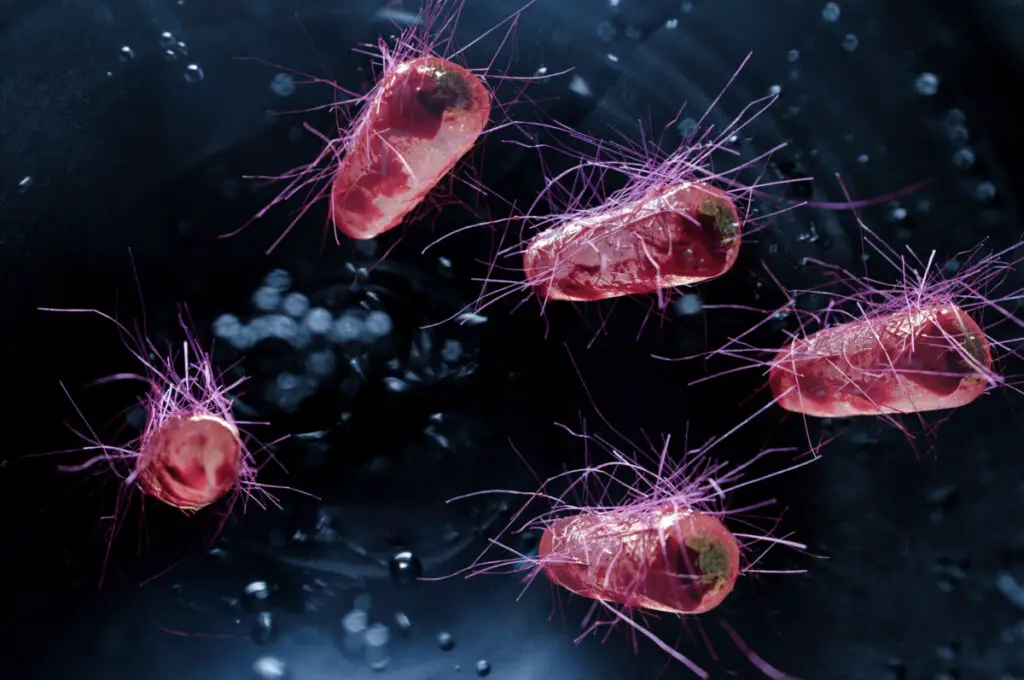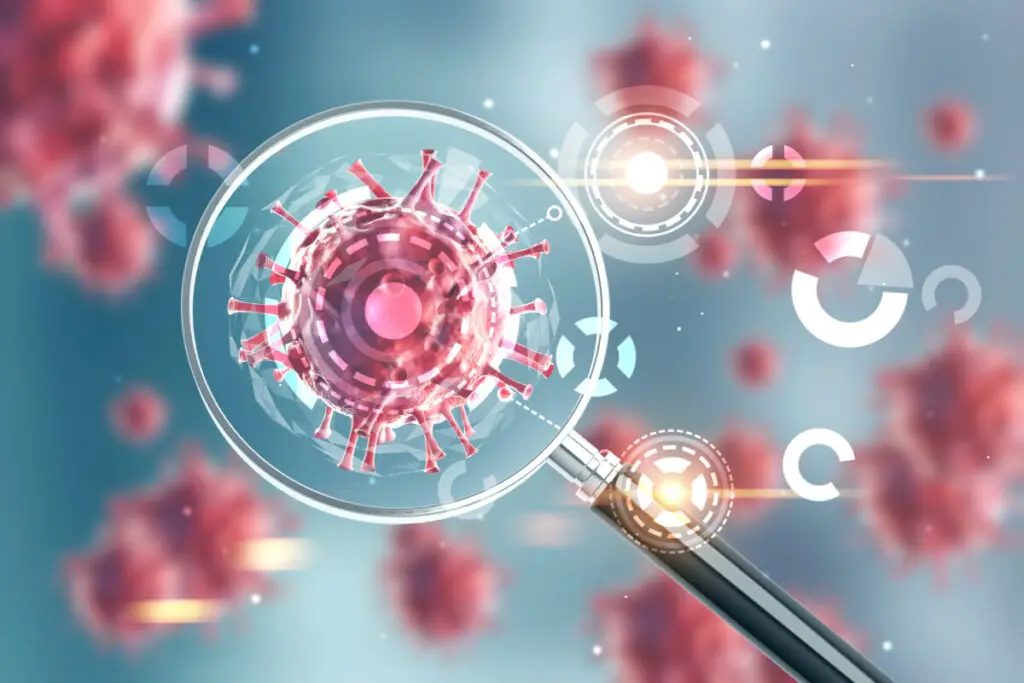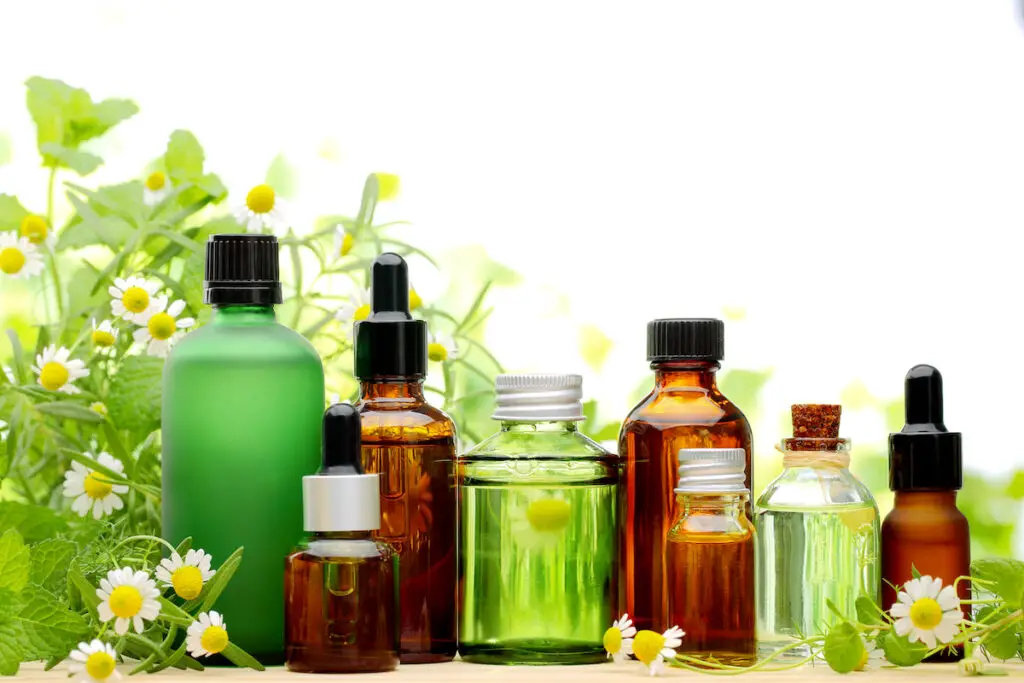Humidifiers do not kill germs that are airborne. Poorly maintained cool mist humidifiers can breed and disperse bacteria and mold spores into the air and have been associated with inflammation of the lungs. Conversely, warm mist humidifiers can kill the germs present in the water tank, and do not disperse pollutants.
Humidifiers are reliable appliances that can improve relative humidity in a dry environment, making it more comfortable. But do they have any effect on germs?
This article takes you through various indoor germs, their sources, and their health effects. It then explains how humidity levels directly impact the growth of multiple pathogens and if humidifiers help with or worsen the problem.
- Humidifiers do not kill germs. However, poorly maintained humidifiers can become a breeding ground for bacteria and mold, and spread them throughout the home.
- Cool mist humidifiers can spread minerals and microorganisms throughout the home, which have been linked to inflammation in the lungs – known as ‘humidifier lung’.
- Warm mist ultrasonic humidifiers can kill microbes contained in the tank water before humidification.
What Are Germs?
‘Germs’ is an umbrella term for all microscopic pathogens like bacteria, molds, viruses, and fungi that can potentially cause disease.
Here are some of the more common germs found inside our homes:
Bacteria

Bacteria are microscopic organisms that carry over 40 different diseases.
They are found in all three major ecosystems, (soil, water, and air), and we are constantly exposed to them.
While some bacteria residing in our gut play a vital role in digestion, most of them are dangerous and pose a risk of health complications like dysentery, etc.
Common bacteria that can become airborne through aerosols:
| Bacteria | Health Effects |
| Salmonella | Salmonella infection causes 420 deaths annually in the United States. The disease can take 6 hours to 6 days to present initial symptoms. Diarrhea, fever, and severe stomach cramps are the main signs. Others include painful urination, joint pain, and eye irritation. |
| E. Coli | E.Coli infections are usually mild and resolve on their own. Some of the symptoms include bloody diarrhea, vomiting, and stomach cramps. |
| Campylobacter | Symptoms of campylobacter infection usually manifest 2 to 5 days after bacterial exposure. Diarrhea accompanied by fever, nausea, and vomiting are initial signs that go away in about a week. |
| Listeria | Listeria infection called listeriosis can lead to fever, chills, stiff neck, confusion, loss of balance, and muscle aches. |
| C. perfringens | C. perfringens usually affects the stomach, and the infection results in a loss of appetite, vomiting, and abnormal bowel movements. The patient may also experience mouth and throat pain. |
| Klebsiella pneumoniae | Pneumonia is a common infection that affects 1.5 million people annually in the US alone. It causes signs like chest pain, confusion, cough, fever, sweating, and chills. |
| Staphylococcus aureus | Staph infection leads to the formation of boils and painful red bumps on the skin. |
| Mycobacterium tuberculosis | The general symptoms of TB disease are rapid and include drastic weight loss, night sweats, and fever. |
Viruses

Bacteria are microscopic organisms that carry over 40 different diseases.
They are found in all three major ecosystems, (soil, water, and air), and we are constantly exposed to them.
They are found in the air and on surrounding surfaces and typically spread through close contact with an infectious person.
Apart from the person-to-person transfer, some viruses can remain suspended in the air for extended periods, resulting in airborne transmission.
The common viruses found in the environment are:
| Virus | Health Effects |
| Influenza | Influenza causes the ‘flu’, and ear and sinus infections. Complications may include bacterial pneumonia and exacerbation of cardiovascular diseases, asthma, or diabetes. |
| Herpes | Airborne transmission of Herpes is rare. Symptoms may include inflammation of CSF (brain fluid) and rectal inflammation. |
| Chickenpox | Chickenpox infection, or Varicella Zosta is primarily an itchy rash that progresses to form fluid-filled blisters and scabs. |
| HPV | The HPV virus can cause painless lumps, but the infection is typically symptomless. |
| Mumps | Mumps is usually recognized by swollen and painful salivary glands, fever, headache, and muscle ache. |
| Measles | The common measles symptoms appear three to five days after pathogen exposure. They include high-grade fever and runny nose. |
| Rubella | Rubella infection causes low-grade fever, headache, cough, swollen lymph nodes, and general discomfort. |
| Common Cold | The common cold infection manifests as sore throat, headaches, cough, high temperature, and sneezing. |
| Covid 19 | It causes acute respiratory distress syndrome (ARDS), organ failure, septic shock, and neurological symptoms. |
Molds and Yeast

Molds are a group of fungi and are larger and more complex than bacteria.
They virtually inhabit everywhere in the surrounding, like in the air, on plants, fruits, etc.
Acremonium, alternaria, aspergillus, fusarium, mucor, are some of the typical molds found indoors. They carry a wide range of health implications such as:
- Severe allergy with rashes, sneezing, itching, and watery eyes
- Headaches
- Difficulty breathing (dyspnea)
- Fatigue
Repeated exposure to mold may have severe and irreversible long-term effects like insomnia and cognitive disabilities (memory loss, trouble concentrating, etc.).
Other types of airborne fungi are the yeast that grows in humid climates.
They can enter the body through skin cuts, mouth, navel, and genital openings. The resultant yeast infection can cause severe rash, burning sensation, and swelling.
How Humidity Affects Germs
Humidity is a measure of the moisture content in the air. The relative humidity (RH) refers to the concentration of water vapors in the air compared to the maximum possible amount the air can hold. RH is calculated as a percentage, and generally, 30 to 50% of RH is considered healthy.
The relationship between humidity and various types of germs is interesting and unique. While some microbes thrive in high RH, others multiply in dry environments.
Different bacteria react differently to humidity levels. Most bacteria require an RH above 60% to grow. High humidity and high temperature favor the metabolic processes of bacteria and help them to grow and reproduce.
The same is true for fungi and mold spores.
In contrast, viruses survive longer in cold and dry (less than 40% RH) environments. According to research, dry weather is also highly effective in viral survival and transmission.
How Humidifiers Affect Germs
To understand how humidifiers affect germs, it is crucial to know how they work.
In general, humidifiers:
- Draw dry air inside the unit, either by a rotating fan or through general air circulation in the room.
- Each humidifier has a water tank that is used to disperse moisture into the air. Different types of humidifiers use a slightly different mechanism to convert water from the tank into mist, vapors, or tiny water molecules that can be added to the air.
- Humidity is increased until the level (chosen on the device control) is reached.
- The humid air is then spread throughout the room. Periodic operation helps maintain the relative humidity at one set level.
There are different types of humidifiers, which interact with our environment differently, these are:
Evaporators
Evaporators or steam humidifiers have a heating element that heats the water up. They also have a fan that speeds up evaporation to increase the rate of humidification.
After evaporation, water vapors are absorbed into a wick filter, and the moistened filter then improves the humidity of the circulating air.
Ultrasonic Humidifiers
Ultrasonic humidifiers come with an ultrasonic disc that vibrates at a high frequency, forcing the tank water to form a fine mist. The molecules produced are tiny and measure about one micron, and are readily absorbed when expelled into the air.
These two types of humidifiers can produce either cool mist, while ultrasonic humidifiers can also produce warm mist.
Can Humidifiers Kill Germs?
Humidifiers do not have specific germicidal mechanisms to kill bacteria and viruses. This means, in general, humidifiers do not kill germs.
However, the hot tank water in warm mist humidifiers can kill germs. The heating element boils the water, which then destroys bacteria and viruses that reside in the tank.
Therefore, warm mist ultrasonic humidifiers can kill the germs present in the tank water.
You can also add a few drops of bactericidal and antifungal essential oils like peppermint, lemongrass, and eucalyptus or antiviral oils like cinnamon and lavender to the water.
Remember to check if your user manual explicitly forbids adding any oils to the tank, as it can sometimes damage plastic components and void your warranty.
Can You Get an Infection From a Humidifier?
While some humidifiers might have a germicidal effect on the water held within the device, they can also breed pathogens and cause infection in adverse situations.
Primarily, there are two ways a humidifier can cause an infection.
The first is by malfunctioning within the unit, causing it to over-humidify or dehumidify the environment.
The second is by harboring germs within the system due to contamination.
Plentiful Air has detailed information on how humidifiers are linked with illnesses available here.
Infection from Humidifier Malfunction
The relative humidity in homes should always be maintained between the recommended range, i.e., 30 to 50%.
Humidifiers can sometimes undergo technical issues, causing them to malfunction. These malfunctions can cause the humidity level in the system to exceed the set limit or fall way below it.
Both cases can lead to the growth of viruses and/or bacteria in the environment.
Here are the most common reasons that can cause a humidifier to stop working properly:
- Faulty Humidistat: Humidifiers have a sensor that measures and displays relative humidity levels of the room. Since the unit has to maintain the RH within a limit, this sensor practically regulates the operation of the appliance.
- If the sensor stops working correctly, it will directly influence the humidification.
- Leaks in Tank: Each humidifier has a specific tank capacity and, based on it, a particular runtime. The water tank is made of plastic and may acquire cracks causing the water to leak. This may disrupt the process.
- Electrical Issues: Each appliance is compatible with a specific voltage. Frequent short-circuits and other electrical problems can interrupt the working. They may also permanently damage the humidifier’s components.
- Technical Issues With Heating Element or Ultrasonic Disc: Ultrasonic disc and heating element are integral components of their respective humidifiers. If they stop working, water won’t be converted into mist or vapors, and thus, humidification will come to a halt.
To prevent health complications, you should always promptly call customer support to diagnose and troubleshoot the problem in your humidifier. Regular maintenance can prevent most issues altogether.
Also read this troubleshoot guide for humidifiers that are not working here.
Infection from Humidifier Lack of Maintenance
Inadequate maintenance can lead to contamination and bacterial development in humidifiers in 5 ways:
- Clogged Filter: Air generally contains pollutants that make their way into the humidifier along with the air. Most humidifiers have a generic cloth filter that removes large particles from the air before it goes for humidification.
- Over time, this filter becomes clogged, and this fails to further trap any pollutants, which can buildup and breed bacteria.
- Mineral Buildup: Mineral buildup due to using hard/mineral water is another reason why your humidifier may be breeding germs. The calcium and magnesium deposits from hardened clogs serve as a continuous nutrition supply for bacteria, hence, providing a favorable breeding ground for various diseases.
- Old Reservoir Water: Standing water facilitates bacterial growth. Leaving the water in the tank when the humidifier is not in use for long (two to three days) can cause all kinds of germs to breed in the tank.
- Corrosion: The ultrasonic disc present in ultrasonic humidifiers is made of metal and can corrode due to air and water. If the metal is not cleaned or changed, rust can cause bacterial growth.
- The Inflow of Highly Contaminated Air: Sometimes, the air quality index (AQI) is extremely poor, and no amount of cleaning and filter replacement can keep dirt and bacteria from building up in the humidifier. Running an air purifier and taking essential measures to improve the air quality can prevent the problem.
The germs that develop inside the unit can then be emitted into the room. Upon exposure to this contamination, you may develop a set of symptoms related to hypersensitivity pneumonitis. This is termed as ‘humidifier lung’.
Keeping up with all the maintenance instructions given in the user manual in check is paramount to preventing the problem.
What Can I Put In My Humidifier To Kill Bacteria?

Since the air in the room circulates through humidifiers, you can undoubtedly put bactericidal substances like essential oils and disinfectant aerosol sprays inside the humidifier to be dispersed into the air.
Essential oils are plant derivatives that have various health effects. They contain secondary metabolites, which are a constituent of many antibiotics as well. These metabolites slow down or inhibit the growth of numerous germs (bacteria, molds, and yeast) and are thus effective in limiting/ preventing infections.
Note that not all essential oils have the same level of bactericidal effect. According to a study, cinnamon oil is the most efficient in killing bacteria. Other options include peppermint and lemongrass oil.
Apart from oils, you may consider adding disinfectant chemicals to the water. However, know that disinfectants may have adverse skin and respiratory allergic reactions upon inhalation.
How Do You Prevent Bacteria From Growing In a Humidifier?
Using only distilled water (or placing a demineralization cartridge in the tank), adequate and regular cleaning of the appliance, and installation of antibacterial filters (if possible), are essential to prevent bacterial growth in humidifiers.
Here are some useful tips to help you keep your humidifier clean, and bacteria free.
1. Regular Cleaning
Cleaning a humidifier is an integral part of its maintenance. None of the techniques to prevent bacterial growth work in the long run if you don’t adequately clean your humidifier regularly.
Here’s how to clean a humidifier:
Clean the External Body
Dust from the air can accumulate on the humidifier surface. Residues from the unit (that are emitted with the air) also gather on it.
Use a dry cloth to clean the unit from the outside. Make sure to turn off and plug out the appliance before cleaning as it can cause electrical accidents otherwise.
Clean the Filter
Humidifier filters are typically present in the motor housing. Over time, they become saturated with dust and debris, unable to remove other contaminants. Cleaning and replacing them when needed is essential.
Refer to your user manual to locate and remove the filter. Then use a dry cloth or vacuum to dust it off. If this doesn’t suffice, rinse the filter under running warm water and let it dry before placing back. Check beforehand if the manual advises against washing as some filter media are prone to water damage.
Other than cleaning, you also need to replace the filter every three months. Signs that severe clogging, swollen filter pores, and frequent overheating of the unit indicate irreversible filter damage.
Descale
Descaling is the removal of mineral build-up or deposits. To descale a humidifier:
- Drain the tank, and fill it with clean water. Empty the tank again after a few minutes.
- Prepare a white vinegar solution (1:1 part vinegar and water) and fill half of the tank with it.
- Let it sit for 20 minutes.
- Drain the tank and wash it until the vinegar smell is gone.
- Lastly, wipe the tank and tank base with a dry cloth.
If your product manual doesn’t advise against using bleach, you can replace the vinegar with a bleach solution (1 tsp bleach in a gallon of water). Vinegar and bleach are strong disinfectants. They don’t only remove scales but also kill bacterial colonies, thus preventing their growth.
2. Distilled Water
As we discussed, mineral build-up from hard water is one of the primary reasons that contribute to bacterial growth in humidifiers. Distilled (demineralized) water does not contain salts and minerals and reduces the potential for bacterial growth from the humidifier.
3. Demineralization Cartridge
In case distilled water is not an option, demineralization cartridges come handy to prevent mineral build-up. They are small devices that remove mineral content from the water.
Drain and rinse the tank, and then place a cartridge inside. Fill the tank and let it demineralize for 10 minutes before starting the humidifier.
It is crucial to note that demineralization cartridges should be replaced every two to three months or frequently, depending on the concentration of salts and minerals. The appearance of white dust around the unit is one of the primary indicators that your cartridge needs to be changed.
4. Antibacterial Filters
Buying humidifiers with pre-installed antibacterial filters is ideal, as it provides better protection against bacterial growth. Almost all modern humidifiers use a generic filter that can trap large airborne particles, but for bacteria and other microbes, a highly-efficient filter with microscopic pores is required.
This is where HEPA filters come in. They can capture particles and organisms as small as 0.3 microns and, therefore, remove 99% of bacteria from the incoming air before circulating it in the system for humidification. This type of arrangement is usually found in air purifiers and humidifier combination devices.
Instead of HEPA filters, some humidifiers also contain ordinary filters coated with antibacterial materials, and they can also effectively prevent bacterial growth in your appliance.
Apart from filters, some units may also employ built-in sterilization techniques to disinfect water.
Two of the best humidifiers that have antibacterial filters include:
1. Afloia 2-in1 HEPA Air Purifier With Humidifier
Afloia’s 2-in-1 HEPA air purifier and humidifier removes microbes. It has a three-tier filtration comprising a pre-filter, HEPA filter, and Activated Carbon filter.
While the HEPA filter removes dust, microscopic particles, and pathogens, the carbon filter absorbs and traps odor molecules and VOCs, thus, ensuring fresh-smelling, clean air. The Pre-filter removes large debris and dust and serves to protect and improve the optimal life of the system components.
2. PureEnrichment MistAire Eva-Mist-Free Evaporative Humidifier
The PureEnrichment MistAire Eva-Mist-Free Evaporative Humidifier has an antibacterial element that is coated with germicidal material. Apart from removing bacteria and molds, it can also trap allergens like pollen, dust, dander, etc.


